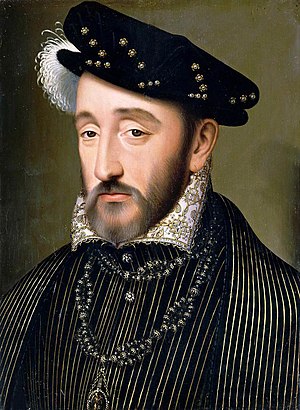Edict of Compiegne
The Edict of Compiègne , French L'édit de Compiègne , was issued on July 24, 1557 by the French King Henry II on his country estate in Compiègne .
introduction
The Edict of Compiègne was the third in a series of edicts that provided increasingly severe penalties for the practice of Protestantism in France. The objective was clearly to eradicate the Reformation . By intensifying measures up to the death penalty , the Edict of Compiègne accelerated the religious crisis that had been simmering for a long time in France and drove the country into civil war between denominational armies. The Huguenot Wars could not be settled until 1598 with the Edict of Nantes , in which Henry IV tolerated the Huguenots .
background
For court reporters, the causative agent (the Huguenot disease ) was clearly in Geneva , where the French-born Johannes Calvin had gained the undisputed supremacy in 1555. In the same year, the French Reformed Church was constituted at a synod in Paris, not far from the royal residence in the Louvre . The Augsburg Religious Peace was also signed in the same year, based on the principle of Cuius regio, eius religio . In other words, the religion of the respective king or ruler was decisive for the religion of his subjects. In Germany, even the little sovereigns could decide on the denomination of the population of their respective country. In France it was therefore formally regarded as a sign of weakness that the king did not seem capable of doing this. As a result, the motto One King, One Faith became the motto of the ultra-Catholic Guisen faction .
The Paris Parliament was completely divided on this question. When the King consulted it about the best course of action to punish and erase heresy, the moderates Pierre I Séguier , President of the Parliament, and the Council du Drac spoke out against the proposed Edict of Compiègne, as they considered it unnecessary. In particular, they opposed the introduction of the Inquisition in France, as this would apparently bypass the royal jurisdiction enshrined in the parliament.
content
The Edict of Compiègne provided for the death penalty :
- for offenses committed by convicted or incorrigible sacramentarians
- for those who moved to Geneva and especially for those who published books there
- for defamation and iconoclastic defacement of saints and their images
- for illegal preaching and participation in religious gatherings of both private and public nature.
The main point of the Edict of Compiègne was the subordination of Protestants who disrupted order in any way under secular jurisdiction. Heresy trial, however, has been left to the hands of the Catholic Church.
As with the Edict of Châteaubriant , the preamble to the Edict of Compiègne noted the ineffectiveness of the courts in their action against the heretics - due to the cunning or indulgence of the judges. The edict made a papal mandate binding, which an inquisition court wanted to set up in France. The parliament delayed the process, only to put it down completely in April 1558.
"On the last day of 1557, the king's followers complained that the court had still not considered the king's last edict, submitted four months ago."
They even understated, because the Edict of Compiègne had already been submitted on July 24, 1557 and then registered in January 1558.
Effects
Nevertheless, the content of the edict had already become public. The first effects became apparent when an angry crowd attacked a Calvinist meeting held in a private house on Rue Saint Jacques . There were nobles, royal officials, respected craftsmen, women and children. About 132 people were arrested and thrown in prison. On September 14th, three of them, including a noble widow, were burned in public on Place Maubert .
